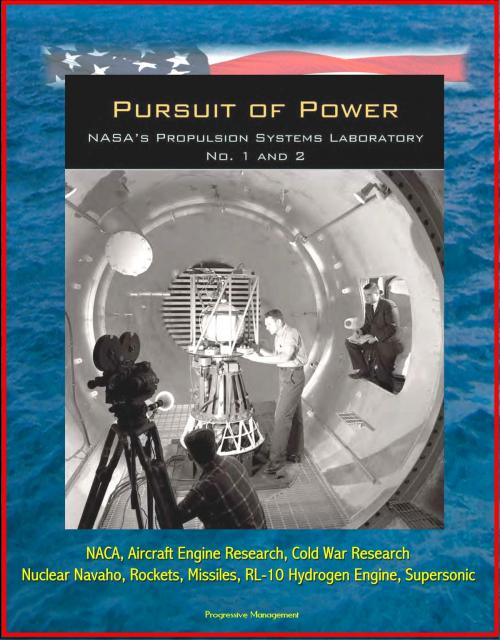Pursuit of Power: NASA's Propulsion Systems Laboratory (PSL) No. 1 and 2 - NACA, Aircraft Engine Research, Cold War Research, Nuclear Navaho, Rockets, Missiles, RL-10 Hydrogen Engine, Supersonic
Nonfiction, Science & Nature, Technology, Aeronautics & Astronautics, Science, Physics, Astrophysics & Space Science| Author: | Progressive Management | ISBN: | 9781301727162 |
| Publisher: | Progressive Management | Publication: | April 13, 2013 |
| Imprint: | Smashwords Edition | Language: | English |
| Author: | Progressive Management |
| ISBN: | 9781301727162 |
| Publisher: | Progressive Management |
| Publication: | April 13, 2013 |
| Imprint: | Smashwords Edition |
| Language: | English |
This is the official history of an important NACA/NASA propulsion research facility located in Ohio, which began operations in 1952 and was demolished in 2009. By the late 1950s, Pratt & Whitney, Wright Aeronautical, and the U.S. Air Force began building their own propulsion labs and altitude facilities. The PSL remained a vital resource by continually upgrading its two chambers, control room, and air-handling system. The installation of a pebble bed heater in the late 1950s permitted hypersonic studies, and the installation of a flamespreader in the mid-1960s allowed more powerful engines to be tested without damaging the cooling equipment. By the 1960s rocket systems of increasing complexity were being studied in both chambers, including an extensive investigation of the Pratt & Whitney RL-10 in PSL No. 1. In the late 1960s, the PSL again turned to airbreathing engines for aircraft. Unlike the studies in the 1950s, this new effort included propulsion systems for civilian aircraft. In 1967, construction was undertaken on a new PSL building with two additional, more powerful altitude chambers, referred to as "PSL No. 3 and 4." All four PSL chambers were used for turbojet and turbofan studies from 1972 to 1979. Budget concerns led to the ultimate shuttering of PSL No. 1 and 2 in 1979.
Contents: Condensed History of the PSL * Preserving the PSL Legacy * Endnotes for Introduction * Acknowledgments * Chapter 1: Legacy of Aircraft Engine Research * Flying High with Feet on the Ground * A Call for Nationalization * Low-Pressure System * Producing Results * Barometer of the Future * Engine Studies in Cleveland * Pulling Ahead * Chapter 2: The Next Big Thing * NACA's Panel of Experts * Congressional Authorization * The Designers * Eugene Wasielewski * Propulsion Systems Laboratory Rising * Executing the Plans * Assembling the Crew * Chapter 3: Harnessing PSL's Muscle * Making Research a Reality * Conducting a Test at the Propulsion Systems Laboratory * Chapter 4: Cold War Weapons * The Nuclear Navaho * Navaho's 48-Inch-Diameter Powerplants * Bob Walker * Getting the Damn Engine to Ignite * Taking Advantage of the Opportunity * Self-Immolation * Coda * Defense Missiles * Howard Wine * Testing the Turbojets * General Electric 1950s Successes * Ill-Fated Avro Project * Chapter 5: The Rocket Era * Cleveland Rockets * Transformation * Hypersonic Heating * John Kobak * Neal Wingenfeld * Homemade Rockets * Star of the Rocket Engine Era * The RL-10 Gets Worked Over * Sitting on Top of All That Hydrogen * Rocket Division Arrives * Primitive Propulsion * End of an Era * Chapter 6: Jet Engines Roar Back * Airbreathing Research Personnel * Supersonic Calibration * Artificial Distortion * Treatments * Slower, Better, Cheaper * The Compass Cope * Hazards Exposed * Chapter 7: The Third Step * Another Giant Emerges * Flutter * Full-Scale Engine Programs * Pratt & Whitney F100 * J85-21 * Highly Maneuverable Aircraft Technology * Fly by Wire * Remote Control * Multivariable Control * Complete Control * Glory Days * Chapter 8: No Tomorrow * The Long Winter * Demolition Decision * Pulling PSL Down * Historical Mitigation * PSL Legacy * Bibliographic Essay
This is the official history of an important NACA/NASA propulsion research facility located in Ohio, which began operations in 1952 and was demolished in 2009. By the late 1950s, Pratt & Whitney, Wright Aeronautical, and the U.S. Air Force began building their own propulsion labs and altitude facilities. The PSL remained a vital resource by continually upgrading its two chambers, control room, and air-handling system. The installation of a pebble bed heater in the late 1950s permitted hypersonic studies, and the installation of a flamespreader in the mid-1960s allowed more powerful engines to be tested without damaging the cooling equipment. By the 1960s rocket systems of increasing complexity were being studied in both chambers, including an extensive investigation of the Pratt & Whitney RL-10 in PSL No. 1. In the late 1960s, the PSL again turned to airbreathing engines for aircraft. Unlike the studies in the 1950s, this new effort included propulsion systems for civilian aircraft. In 1967, construction was undertaken on a new PSL building with two additional, more powerful altitude chambers, referred to as "PSL No. 3 and 4." All four PSL chambers were used for turbojet and turbofan studies from 1972 to 1979. Budget concerns led to the ultimate shuttering of PSL No. 1 and 2 in 1979.
Contents: Condensed History of the PSL * Preserving the PSL Legacy * Endnotes for Introduction * Acknowledgments * Chapter 1: Legacy of Aircraft Engine Research * Flying High with Feet on the Ground * A Call for Nationalization * Low-Pressure System * Producing Results * Barometer of the Future * Engine Studies in Cleveland * Pulling Ahead * Chapter 2: The Next Big Thing * NACA's Panel of Experts * Congressional Authorization * The Designers * Eugene Wasielewski * Propulsion Systems Laboratory Rising * Executing the Plans * Assembling the Crew * Chapter 3: Harnessing PSL's Muscle * Making Research a Reality * Conducting a Test at the Propulsion Systems Laboratory * Chapter 4: Cold War Weapons * The Nuclear Navaho * Navaho's 48-Inch-Diameter Powerplants * Bob Walker * Getting the Damn Engine to Ignite * Taking Advantage of the Opportunity * Self-Immolation * Coda * Defense Missiles * Howard Wine * Testing the Turbojets * General Electric 1950s Successes * Ill-Fated Avro Project * Chapter 5: The Rocket Era * Cleveland Rockets * Transformation * Hypersonic Heating * John Kobak * Neal Wingenfeld * Homemade Rockets * Star of the Rocket Engine Era * The RL-10 Gets Worked Over * Sitting on Top of All That Hydrogen * Rocket Division Arrives * Primitive Propulsion * End of an Era * Chapter 6: Jet Engines Roar Back * Airbreathing Research Personnel * Supersonic Calibration * Artificial Distortion * Treatments * Slower, Better, Cheaper * The Compass Cope * Hazards Exposed * Chapter 7: The Third Step * Another Giant Emerges * Flutter * Full-Scale Engine Programs * Pratt & Whitney F100 * J85-21 * Highly Maneuverable Aircraft Technology * Fly by Wire * Remote Control * Multivariable Control * Complete Control * Glory Days * Chapter 8: No Tomorrow * The Long Winter * Demolition Decision * Pulling PSL Down * Historical Mitigation * PSL Legacy * Bibliographic Essay















